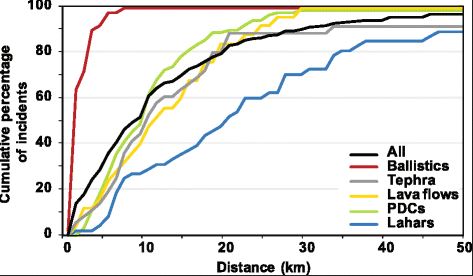9 October 2017
Lahars: an analysis of their role in losses from volcanic eruptions
Posted by Dave Petley
Lahars: an analysis of their role in losses from volcanic eruptions
A lahar ( /ˈlɑːhɑːr/) is a type of mudflow or debris flow composed of a slurry of pyroclastic material, rocky debris, and water. The material flows down from a volcano, typically along a river valley.
This video, which shows three powerful lahars (for example from Mount Unzen in 1993), is a dramatic illustration of the power and violence of these landslides:
.
In a paper just published online (and open access) in the Journal of Applied Volcanology (Brown et al. 2017), Sarah Brown and colleagues from the University of Bristol have looked at the role of lahars, and other phenomena such a pyroclastic density currents, play in causing loss of life in volcanic events. This work analyses a volcanic fatality database that extends from 1500 AD to 2017, and includes 635 separate volcanic events that have resulted in almost 280,000 fatalities. In terms of landslides, they record three types of event:
- Lahars: 72 events, 49,938 fatalities
- Secondary lahars: 41 events, 6,377 fatalities
- Avalanches: 9 events, 3,525 fatalities
In this case, secondary lahars are defined as events that occur after an eruptions (sometimes years later), whilst avalanches are defined as being “inclusive of debris avalanches, sector collapse and landslides: These result from the collapse of unstable edifices due to seismicity, eruption or intense rainfall. Avalanches discharging into lakes or oceans can generate tsunamis; resultant fatalities are classified under tsunami.”
Thus, landslides of one type or another have been responsible for 59,840 fatalities, about 21.5% of the total, and roughly the same number as pyroclastic density currents.
One other aspect of this work is really interesting, which is that the research has examined how far away from the volcano the victims were located when they died, classified by the phenomenon that killed them:-

“The cumulative percentage of fatal incidents by selected eruptive hazard with distance. … Incidents are counted in 1 km bins.” Note the interesting distance profile of lahars. Diagram and caption from Brown et al. (2017)
.
Lahars have a notably different distance profile from the other major volcanic hazards, with significant numbers of deaths occurring at more than 20 km from the volcano. This is a good illustration of the role that landslides can play in extending the reach of a hazardous phenomenon over a long distance, in a manner similar to the way that tsunamis extend the reach of earthquakes.
Reference
Sarah K. Brown, Susanna F. Jenkins, R. Stephen J. Sparks, Henry Odbert and Melanie R. Auker 2017. Volcanic fatalities database: analysis of volcanic threat with distance and victim classification. Journal of Applied Volcanology, 6, 15. https://doi.org/10.1186/s13617-017-0067-4


 Dave Petley is the Vice-Chancellor of the University of Hull in the United Kingdom. His blog provides commentary and analysis of landslide events occurring worldwide, including the landslides themselves, latest research, and conferences and meetings.
Dave Petley is the Vice-Chancellor of the University of Hull in the United Kingdom. His blog provides commentary and analysis of landslide events occurring worldwide, including the landslides themselves, latest research, and conferences and meetings.